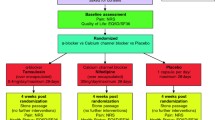Abstract
It has recently been demonstrated that specific adrenoceptors subtypes (α1A/α1D) are prevalent in the distal part of the ureter, a finding supporting the interesting results obtained by different groups with the use of tamsulosin in the treatment of distal ureteral calculi. We performed a prospective randomized study to evaluate the effects of the addition of tamsulosin on our standard pharmacological therapy for the treatment of selected ureteral stones. A total of 64 patients referred to our department for the management of symptomatic ureteral calculi were considered. Patients were randomly divided into two treatment groups: group A (n=32) who received diclofenac (100 mg/daily) plus aescin (80 mg/daily) and group B (n=32) who received the same therapy plus tamsulosin (0.4 mg/daily) for a maximum of 2 weeks. No significant differences were found between the groups for age, gender distribution and mean stone size measured in the single largest dimension at presentation. The stone expulsion rate was 60% (19/32 patients) for group A and 88% for (28/32) for group B with a mean expulsion time of 7.4±2.2 (range 3.5–12) and 4.8±2.7 days (range 1.8–10.5), respectively. Group B showed a significant advantage in terms of both expulsion rate (P=0.01) and expulsion time (P=0.005). Different analgesics from those used in the standard treatment regimen were required in ten patients in group A (31%) but only three patients in group B (9%). This difference was significant (P=0.003). Hospitalization for recurrent colic was needed in 21% of patients in group A (7/32) and in 9% in group B (3/32) (P=0.01). Only two patients in each group (6%) experienced minor side effects associated with the expulsive therapy. Our data confirm the efficacy of tamsulosin in the treatment of distal ureteral stones up to 1 cm. This selective α-blocker should therefore be included in the pharmacological regimen of patients when a conservative approach is considered in the treatment of ureteral lithiasis.

Similar content being viewed by others
References
Dunn JC, Matheson A, Faulds DM (2002) Tamsulosin. Drugs Aging 19: 135
Pak CY (1998) Kidney stones. Lancet 351: 1797
Carstensen HE, Hansen JS (1973) Stones in the ureter. Acta Chir Scand 433: 66
Segura JW, Preminger GM, Assimos DG et al. (1997) Ureteral stones clinical guidelines panel summary report on the management of ureteral calculi. J Urol 158: 1915
Borghi L, Meschi T, Amato F et al. (1994) Nifedipine and methylprednisolone in facilitating ureteral stone passage: a randomized, double blind, placebo controlled study. J Urol 152: 1095
Cooper JT, Stack GM, Cooper TP (2000) Intensive medical management of ureteral calculi. Urology 56: 575
Porpiglia F, Destefanis P, Fiori C et al. (1996) Effectiveness of nifedipine and deflazacort in the management of distal ureteral stones. Urology 56: 579
Obara K, Takeda M, Shimura H et al. (1996) Alpha-1 adrenoreceptors subtypes in the human ureter. Characterization by RT-PCR and in situ hybridization. J Urol [Suppl] 155: 472A
Morita T, Wada I, Saeki H et al. (1987) Ureteral urine transport: changes in bolus volume, peristaltic frequency, intraluminal pressure and volume of flow resulting from autonomic drugs. J Urol 137: 132
Ukhal M, Malomuzh O, Strashny V (1999) Administration of doxazosine for speedy elimination of stones from lower part of ureter. Proceedings XIV EAU Meeting, Stockholm 1999
Sigala S, Dellabella M, Milanese G et al. (2004) Alpha-1 adrenoceptor subtypes in men iuxtavesical ureters: molecular and pharmacological characterization. Eur Urol [Suppl] 3: 119
Cervenakov I, Fillo J, Mardiak J et al. (2002) Speedy elimination of ureterolithiasis in lower part of ureters with alpha 1-blocker tamsulosin. Int Urol Neprhol 34: 25
Dellabella M, Milanese G, Muzzonigro G (2003) Efficacy of tamsulosin in the medical management of juxtavesical ureteral stones. J Urol 170: 2202
Porpiglia F, Ghignone G, Fiori C et al. (2004) Nifedipine versus tamsulosin for the management of lower ureteral stones. J Urol 172: 568
Kupeli B, Irkilata L, Gurocak S et al. (2004) Does tamsulosin enhance lower ureteral stone clearance with or without shock wave lithotripsy? Urology
Salman S, Castilla C, Vela Navarrete R (1989) Action of calcium antagonists on ureteral dynamics. Acta Urol Esp 13: 150
Hubner WA, Irby P, Stoller ML (1993) Natural history and current concepts for the treatment of small ureteral calculi. Eur Urol 24: 172
Teichman JM (2004) Clinical practice. Acute renal colic from ureteral calculus. N Engl J Med 350: 684
Sirtori CR (2001) Aescin: pharmacology, pharmacokinetics and therapeutic profile. Pharmacol Res 44: 183
Lotan Y, Gettman MT, Roehrborn CG et al. (2002) Management of ureteral calculi: a cost comparison and decision making analysis. J Urol 167: 1621
Author information
Authors and Affiliations
Corresponding author
Additional information
Presented in part at the 27th SIU meeting held in Honolulu, Hawaii, 3–7 October 2004
Rights and permissions
About this article
Cite this article
Autorino, R., De Sio, M., Damiano, R. et al. The use of tamsulosin in the medical treatment of ureteral calculi: where do we stand?. Urol Res 33, 460–464 (2005). https://doi.org/10.1007/s00240-005-0508-0
Received:
Accepted:
Published:
Issue Date:
DOI: https://doi.org/10.1007/s00240-005-0508-0




